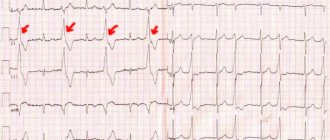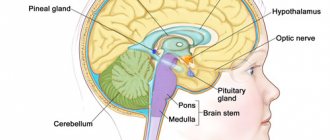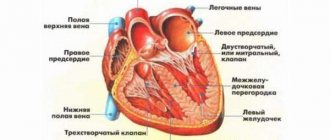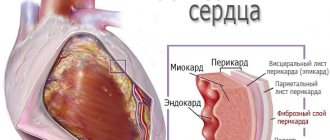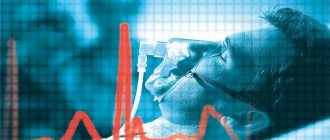Causes of myocardial infarction
The direct cause of pain is myocardial hypoxia caused by acute disruption of the blood supply to the heart. As a rule, a heart attack is preceded by long-term chronic heart failure. An attack can be triggered by physical work, stress, emotional tension, overeating, and alcohol.
The main pathological processes causing a critical decrease in blood flow that does not satisfy the needs of the myocardium are:
1.
Atherosclerosis .
The growth of specific plaques on the inner wall of the vessel, reducing its lumen and elasticity. 2. Thrombosis . The appearance of a blood clot as a result of a local coagulation disorder due to the disintegration of an atherosclerotic plaque.
3. Thromboembolism . Entry into the coronary artery system of an embolus formed as a result of endocarditis or pathology of the heart valves.
4. Coronary spasm. A spasm of cardiac vessels that persists for 15 minutes or more causes the death of myocardiocytes.
The localization of foci of necrosis, their extent and the pain that will bother the patient during a myocardial infarction are directly related to which of the two arteries supplying the heart or their branches is obstructed. For this reason, there are two options:
- left ventricular (anterior, posterior, lateral walls and interventricular septum) as a result of impaired blood circulation in the circumflex and descending branches of the left coronary artery;
- right ventricular (the walls of the right ventricle and the posterior part of the interventricular septum), occurs when the branches of the right coronary artery are affected.
We recommend reading about the treatment of myocardial infarction in a hospital. You will learn about the basic principles of treatment of MI, emergency treatment of pain shock, and treatment of pain in a hospital setting. And here is more information about the diet after myocardial infarction.
Ataralgesia – a combination of an analgesic and a tranquilizer
This combination gives approximately the same analgesic effect as neuroleptanalgesia, but less disrupts breathing, intracardiac and systemic circulation. Ataralgesia is prescribed to patients with serious diseases of internal organs, especially for elderly patients.
The method helps:
- reduce peripheral vascular resistance, and, consequently, the load on the heart;
- accelerate the onset of the analgesic effect and prolong its effect;
- slow down the spread of pain impulses, reduce susceptibility to them.
Analgesics are selected from the narcotic or non-narcotic subgroup (similar to mixtures for neuroleptanalgesia), and the tranquilizer is usually Diazepam, Relanium.
Watch the video about myocardial infarction, assistance and treatment:
Types of pain
Painful sensations usually directly indicate their source. But sometimes there is a so-called irradiation of pain, which is noted quite often during myocardial infarction. Then the pain is felt in a completely different place from where it originated. In acute ischemic heart disease, two main types of cardialgia are observed:
- typical;
- atypical.
Typical pain syndrome
Pain in the heart during myocardial infarction begins suddenly with a rapid increase in intensity. The suffering usually does not improve within 30 minutes and may even worsen without help. A burning or squeezing pain is felt behind the sternum and extends to the neck and shoulder girdle. Taking nitroglycerin does not relieve the patient from suffering. An indicative situation is when a person grabs his chest with his hands.
Atypical pain syndrome (peripheral)
The initial symptoms of a cardiac catastrophe may appear differently.
Localization of pain during myocardial infarction sometimes simulates otitis media, dental problems, acute neurological manifestations of cervical or thoracic osteochondrosis, myositis and other diseases. Diagnostic errors usually result from pain in the lower jaw, cervicothoracic spine, throat and ear, shoulder blade, and left arm.
In addition to cases of pain projected to areas distant from the heart, there are other options for the atypical course of the disease. They may be painless or manifest as a clinical picture of other pathological conditions or damage to other organs. This is typical for patients over 60 years of age and people with chronic diseases.
Of the main features
The described heart damage is manifested by characteristic symptoms.
The most common ones are the following:
- Prolonged pain, preferably localized in the chest area. Discomfortable, aching sensations do not subside for several days, while Nitroglycerin taken does not have the desired effect. A person in such a state cannot breathe deeply and evenly, and acutely feels a lack of air. In some cases, there is an increase in body temperature, and a painful attack lasts from several days to several weeks, it all depends on the extent of the affected area.
- Myocardial infarction causes hypotension, the degree of progression of which depends on the complexity of the disease.
- Already after one hour after the attack, an increased number of leukocytes can be detected in a blood test; this indicator persists for several days from the onset of the disease.
- Accelerated erythrocyte sedimentation reaction, which is already characteristic of the second phase of the pathology.
- A sharp jump in blood sugar, which usually returns to normal in the next week. If there is no improvement, the patient may be diagnosed with diabetes.
- Changes in cardiac electrocardiogram parameters. To accurately determine the presence of myocardial infarction, the patient undergoes several ECG procedures.
A person cannot independently determine the main cause of the described pathology (thrombus), since there are no obvious and specific symptoms of its manifestation. If the condition worsens in the future and complications develop, angina pectoris is likely to occur.
The risk zone includes young people who do not follow a daily routine and whose daily diet contains harmful foods. The occurrence of a heart attack is promoted by regular consumption of alcoholic beverages and smoking. Other reasons for the development of the described heart disease include sudden changes in blood pressure and increased cholesterol due to frequent consumption of fatty, high-calorie foods.
Important! Added to the above factors, regular psychological and emotional breakdowns and lack of mobility over time provoke the occurrence of discomfort in the chest area. This indicates the possible development of myocardial infarction.
Clinical forms
The combination of various options for the location of necrosis, their depth, prevalence, involvement of pathways, and instability over time form an unpredictable negative effect on hemodynamics and the condition of other organs and systems. This causes a variety of clinical manifestations:
Abdominal (gastralgic)
Often myocardial infarction affecting the posterior wall of the left ventricle is manifested by abdominal pain, congestion, bloating, nausea, hiccups and vomiting. During the examination, a tense abdominal wall and a pronounced painful reaction to palpation are determined in the epigastrium. Clinical symptoms are similar to those found in peptic ulcers, gastritis, pancreatitis, and cholecystitis.
Asthmatic
Sometimes the clinical picture of the onset of the disease is typical of cardiac asthma or pulmonary edema. Patients are bothered by a feeling of suffocation, shortness of breath, cough with foamy sputum. It is observed with a rapid increase in left ventricular and right ventricular failure. May resemble bronchial asthma.
Cerebral
Often a catastrophic situation resembles a dynamic circulatory disorder of the brain. Headache with this peculiar manifestation of myocardial infarction is accompanied by tinnitus, fainting, dizziness, motor and sensory disorders. Characteristic of elderly patients with cerebral atherosclerosis. It can be difficult to differentiate from a stroke.
Arrhythmic
Extensive areas of myocardial death, especially affecting the interatrial and interventricular septum, damage the conduction pathways of the heart. Arrhythmic infarction is usually spoken of with the development of ventricular fibrillation, paroxysmal tachycardia and atrioventricular block with loss of consciousness, when the pain syndrome is not expressed or is absent.
Erased (painless)
Intermittent and quickly passing symptoms of weakness, shortness of breath, sweating, sleep disturbances, and a feeling of discomfort in the chest may be the only witnesses to myocardial infarction without pain. Detected by electrocardiography. It occurs, in particular, in people who have had diabetes for a long time.
We recommend reading about the abdominal form of myocardial infarction. You will learn about the types of atypical course of cardiac muscle necrosis, clinical symptoms of the abdominal form of MI, treatment during the first 24 hours. And here is more information about the necessary laboratory diagnostics for ischemic heart disease.
Symptoms
In modern medicine, it is customary to identify the following signs that are unusual for heart disease:
- Gastritis. This set of symptoms disguises a heart attack as gastritis or an ulcer. Occurs due to damage to the posterior wall of the heart. Unpleasant sensations arise due to the fact that the necrotic area is located next to the diaphragm.
- Asthmatic variant of heart attack. The symptoms resemble asthma and are observed due to damage to the left ventricle. When the left atrium becomes overfilled with blood, congestion in the pulmonary circle and pulmonary edema occurs. This form of heart attack is characterized by the absence of pain. It is associated with dystrophic changes in nerve endings and myocardium, which occurs during prolonged ischemia. Mostly asthmatic infarction affects elderly patients. The prognosis is unfavorable.
- Painless heart attack. The disease is often diagnosed in elderly patients, diabetics and alcoholics. This form of the disease is characterized by sleep disturbances, low mood and discomfort in the cardiac region. However, most patients neglect these manifestations. You should pay attention to additional symptoms such as excessive sweating, spontaneous dizziness, shortness of breath, low-grade fever and pre-edema of the legs. For painless heart disease, doctors make the most unfavorable prognosis, since the absence of pain indicates chronic heart damage.
- Edema infarction. During a recurrent infarction or in patients who suffer from arterial hypertension, the attack may not be accompanied by pain and may manifest as sudden onset of right ventricular failure. This type of myocardial infarction is characterized by swelling of the lower extremities and swelling of the veins in the neck. This symptomatology in elderly patients indicates a silent heart attack.
- Arrhythmic infarction. If a person suddenly experiences an abnormal heart rhythm of unknown origin, it is important to undergo an examination to rule out heart disease.
- Brain infarction. The first sign of the disease is an acute headache. As a result, the patient’s vision may deteriorate, fainting, and vomiting is possible. In some situations, plegia (paralysis) is observed. During myocardial necrosis, anoxia (insufficient oxygen supply) occurs, resulting in cerebral vascular spasm. After the patient regains consciousness, he notes pain in the sternum area typical of myocardial infarction.
During an attack, a person’s blood pressure drops sharply. This is due to the fact that the volume of ejected blood decreases due to a decrease in actively contracting muscle tissue.
In patients suffering from arterial hypertension, as well as in young patients, the decrease in blood pressure occurs delayed, but it is always observed.
A strong decrease in blood pressure provokes cardiogenic shock. If the heart rhythm is disturbed, we are talking about a large-scale focus of necrosis. It is possible that muscle tremors and vomiting may occur, which are the body’s reaction caused by severe pain and a drop in blood pressure.
An equally significant symptom that occurs on the 2nd day after the attack is an increase in body temperature. It returns to normal after about 10 days. The increase is a response to necrotic tissue. Doctors must take this sign into account when making a final diagnosis.
A typical pain syndrome is the first sign that allows one to suspect the onset of an attack of myocardial infarction and gives rise to a targeted examination. As a rule, the patient will need to attend an electrocardiogram, ultrasound examination of the heart, coronary agiography, and also undergo a general blood test.
How to distinguish pain from angina and heart attack
It is vitally important to be able to distinguish cardialgia from angina pectoris and from myocardial infarction, because treatment started late can lead to tragic consequences. It is necessary to compare several criteria to see the differences and make the correct diagnosis.
| Differences between attacks during MI and angina pectoris | a brief description of |
| Duration | Angina pectoris is characterized by development in the form of a series of attacks after physical exertion or psycho-emotional arousal. Lasts from 5 to 15 minutes with pain easing between episodes. The duration of pain in the acute period of myocardial infarction is much longer, especially if treatment is delayed, then it may not end for several hours. |
| Intensity | With angina, the pain gradually becomes very severe, but tolerable. The suddenness of the onset of pain is more typical for myocardial infarction, in which it quickly grows and acquires unbearable and painful strength. |
| Parallel symptoms | During an attack of angina, it is usually absent. Myocardial infarction is almost always accompanied by a fear of death with vegetative disorders in the form of cold sweat, the rhythm may be disrupted for the first time, and AV blockade may occur. |
| Efficiency of nitrates | 3 to 5 minutes after using nitroglycerin, angina begins to subside, and a clear improvement is observed. And, on the contrary, the use of nitroglycerin does not have a significant effect on the nature of pain during myocardial infarction. |
| Localization | During an angina attack, pain is usually felt only behind the sternum, and the heart attack also affects the area of the neck and shoulder girdle on the left. |
First aid
The prognosis for a patient with a heart attack depends on the speed and correctness of first aid. After calling an ambulance, the actions should be as follows:
- Place the person on a flat surface and raise their head slightly. If you have shortness of breath, you can take a sitting position with your legs down.
- Provide air access: open the window, unfasten the top buttons of clothing.
- If there is no allergy, then the patient should be given an Aspirin tablet, which helps resolve the blood clot. The drug does not provide a therapeutic effect, but it reduces the intensity of pain.
- Nitroglycerin does not reduce pain, but helps relieve shortness of breath. The drug should be given every 15-20 minutes, but no more than 3 tablets.
- If epigastric pain appears during an attack of myocardial infarction, you can give an anesthetic or take a soda solution to eliminate heartburn.
The medications taken may not improve the person’s condition, but they will help the ambulance crew make a diagnosis more easily.
What to do if you suspect the onset of a heart attack
The future fate of the patient depends on how quickly and correctly assistance is provided in the first minutes of the disease. Before the patient is in the hands of doctors, it is necessary to perform simple measures that will reduce the myocardium’s need for oxygen and can reduce the area of ischemic necrosis:
1. Call an ambulance immediately.
2. Stop physical activity. Sit or lay down the patient, sometimes urgently.
3. Provide fresh air. If necessary, unbutton your collar, open the window, turn on the fan.
4. Help take antianginal medications. Nitroglycerin 1 - 2 tablets (2 - 3 drops) under the tongue two or three times before the ambulance arrives with an interval of 15 - 20 minutes.
5. Reduce the patient's anxiety. Give drops of valocordin, corvalol, motherwort or valerian preparations to drink.
6. It is worth trying to reduce the pain. You can give the patient analgin or a non-steroidal anti-inflammatory drug.
7. Provide everything necessary and help get ready for the hospital.
The role of pain during myocardial infarction is difficult to overestimate. It makes one aware of the impending disaster and encourages immediate action aimed at minimizing the consequences of this disease. It is important to correctly interpret its manifestations and recognize painful symptoms in time. Quick implementation of a few simple recommendations will help save the lives of loved ones and avoid unpleasant complications.
What to do if you have chest pain
If an attack of angina can be easily stopped with a Nitroglycerin tablet, then only narcotic analgesics can cope with myocardial infarction. To differentiate between ordinary spasm of the coronary vessels and their blockage with a blood clot, you should try to relieve pain with the help of organic nitrates. If nitroglycerin is ineffective, this is a reason to call an ambulance. A team of specialists must correctly determine the boundaries of the heart and stop the attack with a strong pain reliever.
Before the doctors arrive you need to:
- provide the patient with complete peace of mind (turn off loud music, eliminate unnecessary conversations, do not name scary diagnoses);
- position the victim correctly (pick up a hard surface, tilt the head back, if vomiting occurs, in addition to the head, turn the whole body to one side);
- open the window for fresh air, unfasten buttons, free your hands from the watch and remove tight underwear to improve the flow of oxygen to the brain;
- if necessary, artificial respiration is performed (the patient's nose is pinched and air is blown through the mouth; a napkin is applied to ensure sterility).
If resuscitation efforts do not bring results, you need to check the patient for a pulse. In its absence, indirect cardiac massage is performed. The hands of the person resuscitating are placed one on top of the other so that the lower palm is 2 cm above the xiphoid process, then pressing movements are carried out. Cardiac massage should be alternated with artificial respiration. Improvement in the patient's condition implies constriction of the pupils, normalization of the pulse and redness of the skin.
Importance of diagnosis
In order to identify the cause and effectively eliminate it, if pain in the heart appears after a heart attack, be sure to consult a doctor. He will prescribe a number of examinations. It can be:
- ECG;
- Ultrasound;
- daily monitoring;
- coronary angiography;
- echocardiography;
- Holter monitoring;
- load tests.
Based on the results of these studies, the cause of the problem will be determined and treatment will be prescribed in accordance with the disease. This will help to avoid a catastrophe in the future, which often costs the patient’s life.
Symptoms of a heart attack: how the first signs of the disease appear
articles
The modern rhythm of life contributes to various disruptions in our body. Therefore, it is necessary to be prepared for any situation. It is extremely important to know the symptoms and signs of a heart attack - one of the most dangerous diseases. Often it is recognized in advance, and such knowledge can help save yourself and your loved ones from unforeseen trouble.
What it is
This disease occurs when some part of the organ dies (necrosis).
Cell death in this case is associated with a lack or absence of blood flow due to blockage, narrowing (especially with atherosclerosis) or spasm of the coronary vessels, which deliver the necessary nutrients and oxygen to the tissues. Once the blood supply becomes insufficient, necrosis begins within 15-30 minutes.
Description
This condition threatens the life of any person. A heart attack can occur in the brain and be accompanied by softening of areas of brain tissue, spleen, kidneys, and intestines. For the latter, necrosis, as a rule, is not life-threatening, but significantly worsens its quality.
Most often, and with more serious consequences, it occurs in the heart muscle. Almost forty percent of deaths occur in the first twenty minutes from its onset, as severe complications develop. 3-6 hours after a critical disruption of blood flow, the area of the heart muscle with which the vessels were connected completely dies.
Doctors distinguish several temporary stages of development. They are determined by the time from the onset of necrosis to its completion:
- acute – lasts less than two hours;
- acute – up to ten days;
- subacute – 10-45 days;
- scarring – from one and a half to six months.
The latter means that our body has coped with the disaster, but its functioning will never return to its previous level - the changes are irreversible.
How does a heart attack manifest?
This disease is very insidious and is not always expressed in the classical form. For various organs, it is usually accompanied by severe pain, inflammation and impaired motor functions.
If we talk about IHD (coronary heart disease), as a rule, a person pays attention to periodic pain in the chest area, which is especially evident after physical activity (exercise, long walking, climbing stairs, etc.). Typically, potential patients suppress this condition with vasodilator medications.
However, when this does not help, and the pain becomes more and more intense, there is a possibility that active cell necrosis has begun. Sometimes the pain becomes so unbearable that it affects psychological well-being: a person may have thoughts of imminent death.
This results in slurred speech and confused, unconscious behavior.
But as noted earlier, the manifestation does not always meet this standard and may be characterized by atypical symptoms. For example, instead of pain, there is simply discomfort, and sometimes not even in the chest, but in the area of the esophagus. Unreasonable shortness of breath and sweating are possible. Such moments are especially difficult when diagnosing.
Leave a request for selection of a boarding house
for an elderly person with a heart attack
Causes of myocardial infarction
In most situations, this is a consequence of a disease such as atherosclerosis. In more than ninety percent of cases, it is this that serves as the background for the flow.
Root causes also include:
- embolism – blockage of blood vessels with gas bubbles or other particles (blood clots);
- fat clots;
- spasms;
- valve disease - when important arteries depart from the aorta;
- changes in blood pressure, as is the case with arterial hypertension.
Due to all of the above, the vascular lumen narrows, preventing the normal functioning of the circulatory system. And if the heart muscle does not receive enough oxygen for 20 minutes, the tissues of its individual sections die. Such phenomena lead to suffocation and brain damage. In extremely difficult situations, cardiac arrest occurs.
However, you should not think that the manifestation of a heart attack is associated only with other diseases. Lifestyle also greatly affects our cardiovascular system.
Regular stress, poor nutrition, and insufficient physical activity or, conversely, excessive exercise lead to its failures.
Especially among the harmful factors, bad habits such as smoking and frequent alcohol consumption stand out.
Types and features
They primarily depend on the organ affected and can be divided into many subtypes according to the site of the lesion. In general (without reference to a specific part of the body), doctors distinguish:
- White (ischemic) - it is associated with blockage of an artery (usually a thrombus or embolus).
- With a hemorrhagic rim - its cause is spasms followed by paralytic dilatation of blood vessels.
- Red - appears due to blockage of the arterial network and veins.
- Aseptic necrosis is usually small in size and undergoes scarring.
If we talk about the heart, then there are types depending on its department:
- left ventricle – most often diagnosed, the death of its anterior wall is especially dangerous;
- right - proceeds the easiest and is the most favorable in terms of prognosis for recovery;
- transmural - the entire thickness of the middle muscle layer is affected, and necrosis often spreads to other cardiac sections;
- subepicardial - with it there is often a risk of death, since rupture of the damaged vessel and hemorrhage into the pericardial cavity can occur.
The main symptoms of myocardial infarction
Men and women over 40 years of age complain more about frequent pain in the chest area. In addition, the pathological process is characterized by high blood pressure. Medical experts identify the following symptoms:
- constant shortness of breath even with slight physical exertion;
- unpleasant feeling of pressure behind the sternum;
- angina attacks;
- cold sweat or increased sweating;
- swelling of the extremities, especially the legs;
- memory impairment, absent-mindedness;
- loss of orientation in space;
- severe muscle weakness.
If any such manifestations occur, you should immediately consult a doctor.
What are the symptoms of a heart attack in women?
This topic is especially acute now because it began to be dealt with not so long ago. It turned out that almost all studies of this disease were carried out on male examples (since they are most often at risk of this disease). But women's symptoms are somewhat different.
As a rule, women after 45 years of age are susceptible to it, especially if they have reduced resistance to stress and hard work. For them, the alarm bells are:
- shortness of breath during sleep and even snoring;
- causeless nausea and vomiting attacks;
- severe bleeding gums;
- frequent urge to urinate at night;
- numbness of body parts;
- swelling of the face, hands and feet, which indicate impaired water balance;
- pain radiating to the left shoulder joint;
- pain in the stomach area;
- frequent migraines;
- abnormal heart rhythm.
The nature of pain at the first symptoms of myocardial infarction
It is often sharp, acute to such an extent that breathing is impaired, limbs are paralyzed and it is impossible to think logically. Pain syndromes can provoke not only dizziness, but even loss of consciousness (this is especially true for women). And if you are not near the person in time and do not provide assistance, tissue necrosis can cost the patient his life.
Feel
the problem is that the pain will not go away even if the person takes painkillers. At first, periodic shooting sensations are felt, which can radiate to the left shoulder.
If it seemed that they disappeared without therapeutic measures, and after a short period of time they returned again, you need to call an ambulance.
The relapse stage is characterized by persistent pain for the patient.
The first signs of myocardial infarction
The progressive process is individual in terms of timing for everyone and makes itself felt in a few days - a month. Pre-infarction condition is determined by such signs as:
- breathing problems: intermittent inhalations and exhalations at night, snoring, shortness of breath;
- pain behind the sternum or in the left shoulder;
- numbness of the limbs even for a short time;
- increased sensitivity and bleeding gums;
- swelling of the legs;
- severe headaches;
- regular attacks of arrhythmia.
The mental state of the patient also changes - he feels discomfort, discomfort, and a sharp fear of death. He does not always control speech and movements. First of all, those who were nearby need to help him take a horizontal position and call an ambulance.
Nervous signs during a heart attack
This process involves the organs of the central nervous system, which complement the picture with typical symptoms:
- decreased visual acuity;
- tremor and numbness of the hands;
- persistent migraine;
- dizziness;
- panic attacks;
- sensitivity disorder of the limbs - paresthesia (burning, tingling, goosebumps);
- insomnia;
- cold sweat;
- and, as stated earlier, obsessions with death.
What to do when symptoms appear
The first step is to call emergency services as soon as possible. You can't let your condition take its course. The sooner professionals begin treatment, the lower the risk of severe consequences and death.
First aid: algorithm of actions
- As soon as the first signs and symptoms of myocardial infarction (and any other) are noticed, the patient needs to limit physical activity and immediately take a lying or semi-lying position.
Under no circumstances should you exercise yourself physically - this puts even more stress on the heart, and there is also a risk of losing consciousness and falling, causing even more damage. - It is important to ensure a flow of oxygen, so tight clothing should be loosened and windows should be opened.
- The victim needs to take a nitroglycerin tablet under the tongue until completely absorbed (no more than three times).
- It is also recommended that the patient swallow chewed aspirin.
- The person next to the victim should not leave him alone. The latter is in dire need of help and support.
It is worth noting that after a heart attack begins, the first hour is called the “golden” hour. And it is extremely important that a team of specialists arrive during this time.
Diagnostics
The main diagnostic technique is ECG (electrocardiography). In most cases, the cardiogram demonstrates all pathological phenomena in the heart muscle. Sometimes they also resort to ultrasound examination (ultrasound), vascular angiography and scintigraphy. To accurately determine the diagnosis, a blood test is required.
Treatment will be carried out only in a special institution, after which rehabilitation is required to prevent recurrences of the disease and stabilize the person’s condition.
Symptoms of complications after a heart attack
Their severity depends on age, the area of tissue affected and the timely professional medical care provided. Among them are:
- arrhythmias (heart rhythm disturbances);
- brain damage;
- strokes;
- pulmonary edema;
- possible mental disorders;
- stomach ulcers;
- cardiogenic shock (sharp decrease in myocardial contractility).
The mortality statistics from this disease are disappointing - every tenth person dies. But you need to understand that many patients who did not survive the attack did not receive full medical care. If you know what symptoms occur before and during a heart attack, you can avoid sad consequences. According to statistics, about 80% of patients lead a normal life after rehabilitation.
Prevention
To avoid any diseases of the cardiovascular system, you should first pay attention to nutrition. The diet should contain a lot of vitamins and fiber and a minimum (or better yet completely eliminate) fatty and fried foods, because they contribute to the appearance of cholesterol plaques. Omega-3 fats, which are contained in fish fillets, have a good effect on the body's condition.
It is important to monitor the condition of your body. If you are overweight, you should definitely lose weight (but be sure to consult your doctor). With a sedentary lifestyle, you need to combat physical inactivity and do physical exercise. Experts also recommend purchasing devices with which you can regularly monitor blood pressure, blood sugar and cholesterol levels.
Rehabilitation: an important step on the path to recovery
In fact, in addition to drug treatment, it includes more stringent measures to prevent the main signs of myocardial infarction:
- Special motor mode. Its limitations are individually related to the stages of necrosis. For older people it is selected with special attention. Don't think that it is possible to quickly return to physical shape. If after a few weeks you can climb one flight of stairs without shortness of breath, weakness or rapid heartbeat, this is a good result.
- Dancing, swimming and cycling will have a beneficial effect on the body.
- Diet. Food is selected that does not burden the body: low-fat dairy products, vegetables, fruits, fish, poultry. Salt consumption is limited.
- Lifestyle changes. The fact that you will have to give up any bad habits is not discussed, since they can negate all treatment. In case of obesity, as mentioned earlier, it is necessary to lose weight to the norm established by the attending physician.
It is worth considering that the older the patient, the more time and attention he needs for rehabilitation. In our network of boarding houses "Zabota" an elderly person who has suffered a heart attack will be provided with the necessary care.
Article creation date:
September 19, 2019
Article updated date:
June 22, 2020 Leave a request for selection of a boarding house
for an elderly person with a heart attack
Source: https://www.pansion-zabota.ru/info/articles/simptomy-infarkta-kak-proyavlyayutsya-pervye-priznaki-bolezni/
